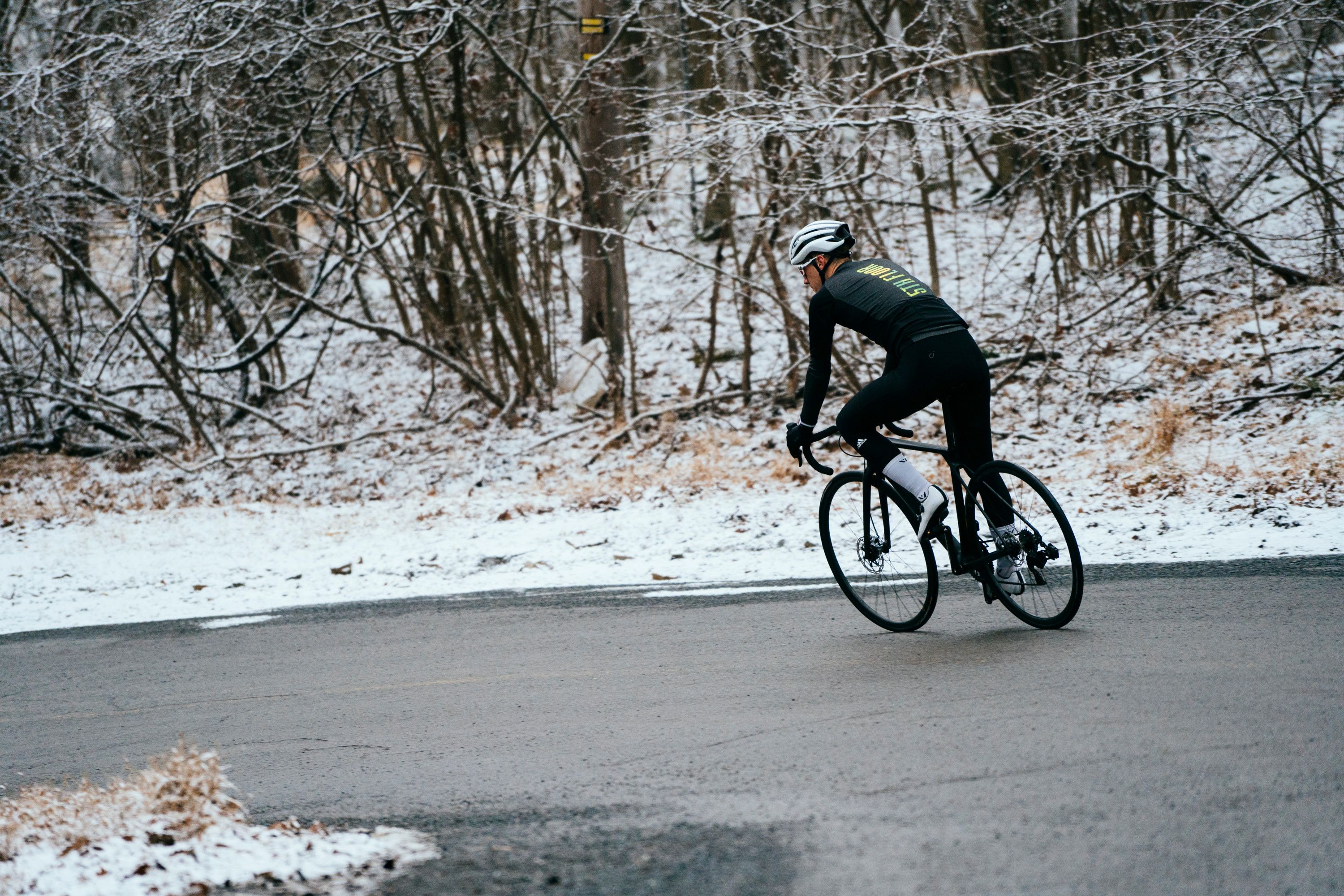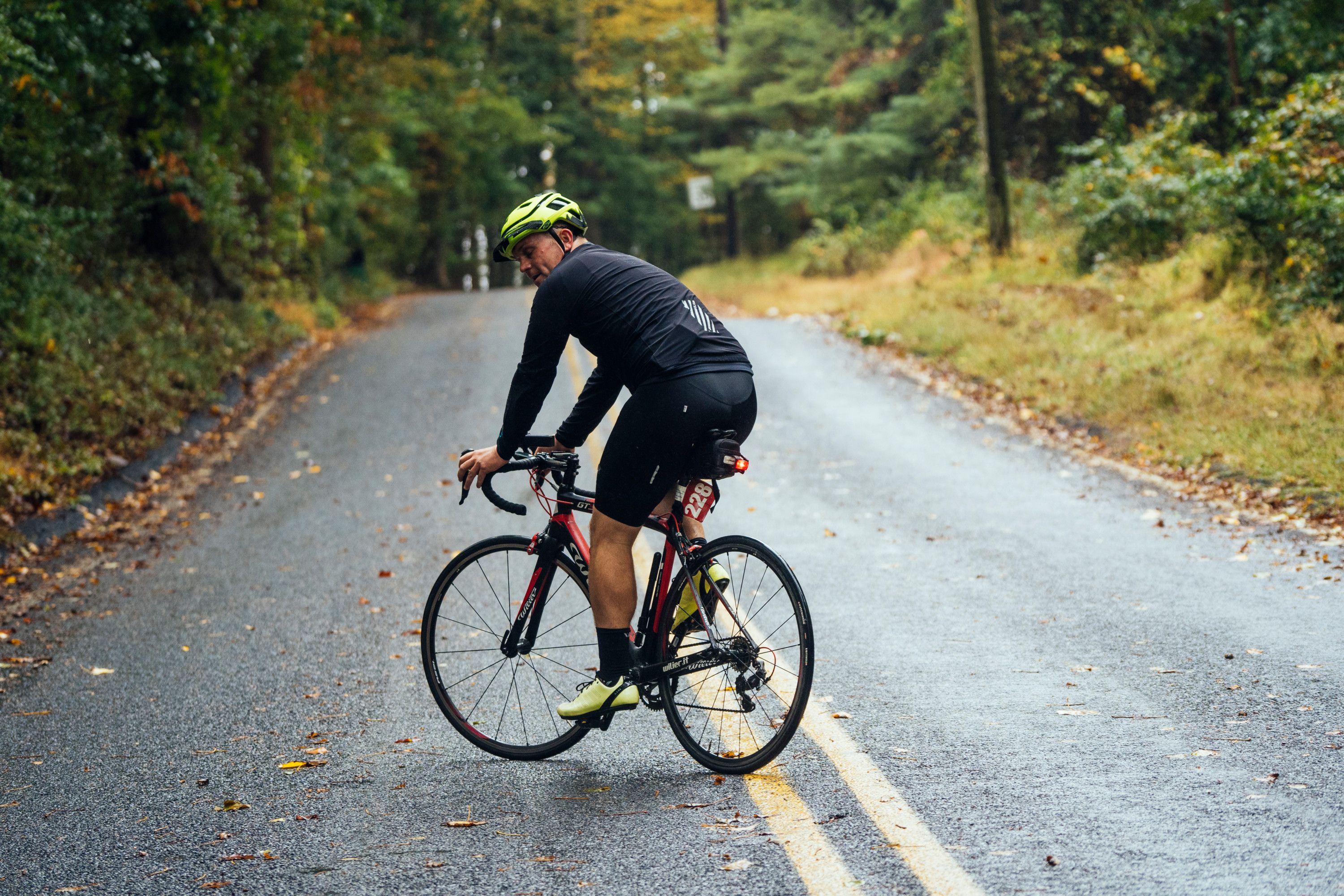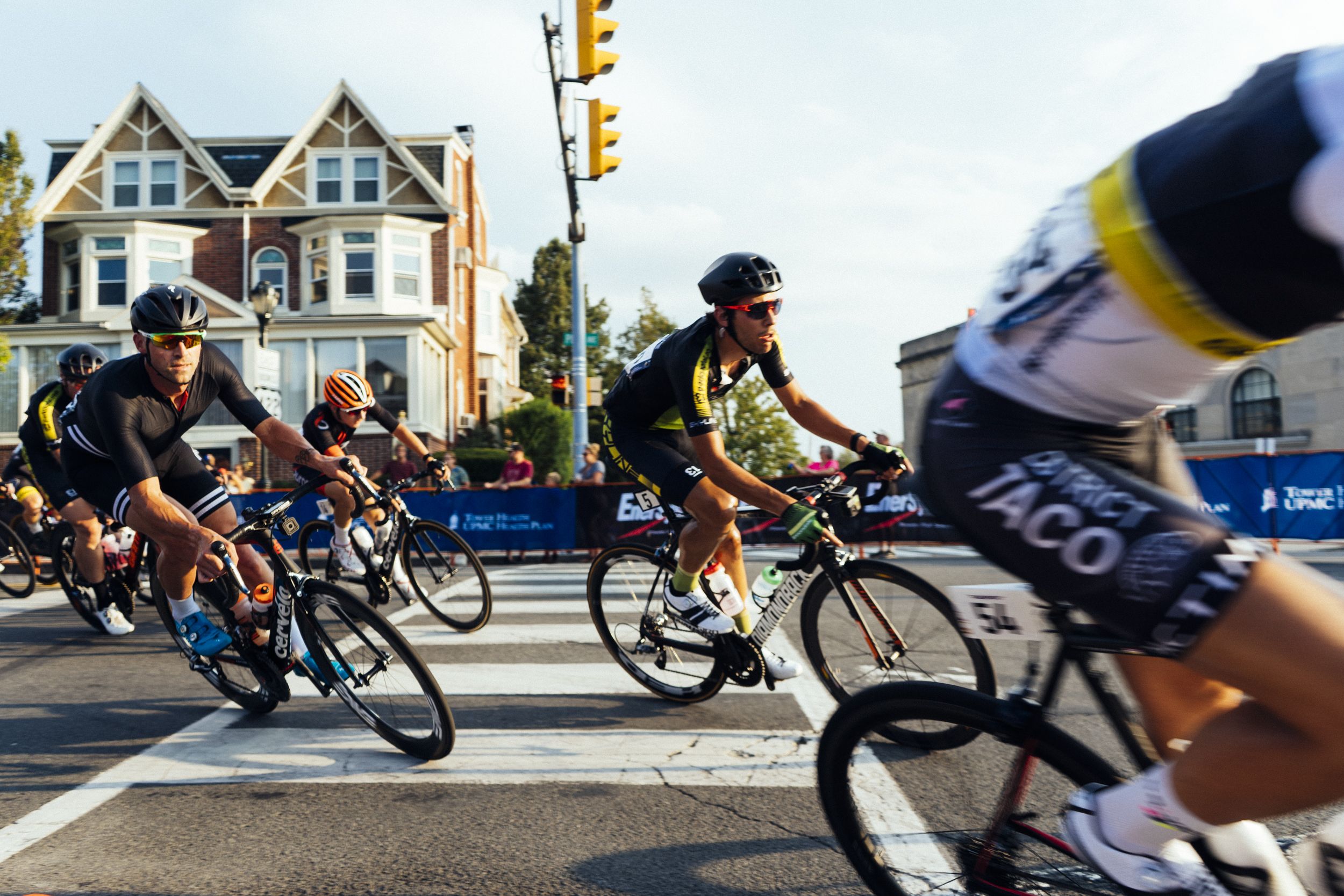Scared of Riding In The Rain? We Can Help…
Riding in the rain needn't be scary - nor should these other four common cycling fears. As always, Selene has the solutions.
We had been climbing in the pouring rain for the better part of an hour, up, up, up, and up some more, when we finally passed the sign marking the Continental Divide, and it was time to ride down, down, down. As I peered at the slick black ribbon of road stretching down into the valley as far as my eyes could see, my heart shot into my throat: Even after 20-plus years of riding and racing bikes of all manners in all types of terrain, I still freaking hate wet road descents. Hate them.
I ride the brakes too hard and swear at myself for riding the brakes too hard, and tell myself how much I suck as riders with seemingly-magical traction zoom by me.
So I called Andy Applegate, a Carmichael Training Systems coach who teaches riding skills to cyclists of every experience level, and unloaded my fears—and then we started talking about other very common cycling fears riders face.
Suddenly I felt better, now armed with some sound strategies to help me keep my cool in the face of cycling’s sometimes-scary situations. Read on, and you’ll learn how to overcome these common cycling fears, too, with Applegate’s tips.
The Fear: Wet Descents

Why you worry: Because wet roads are slippery and crashing hurts. That’s legit. But there are simple steps you can take to maintain traction and stay relaxed while staying rubber side down.
Tips to Handling It
1. Drop psi
Mountain bikers do it all the time, but it often doesn’t occur to road riders to lower their tyre pressure for better traction, especially when it’s wet. “Taking your tyres down 10psi can make a huge difference,” says Applegate. “You can really feel your tyres sticking to the road better.”
2. Change your braking ratio
Your front brake is far more powerful than your rear. Pulling it too hard on a wet descent can make your front wheel wash out, sending you to the pavement in a hurry. “Generally, I coach people to pull both brakes fairly evenly,” says Applegate. “When it’s wet, however, you should go easy on the front and use more of the rear.”
3. Scrub speed
Unless you have disc brakes, it takes considerably longer to stop when your rims are wet. Keep your speed in check by gently squeezing your brakes. This is especially important through turns, when you want to avoid braking in the turn itself as much as possible.
4. Use your weight
Keeping your weight squarely over your tyres will help keep them on the road. “You want to keep your center of gravity as close to vertical over the your tyre’s contact point on the road as possible,” says Applegate. “That means leaning your bike, but not your body, into turns and pressing all your weight on the outside pedal.”
The Fear: Getting Dropped
 Why you worry: “Ego,” says Applegate. While new riders are sometimes legitimately afraid of getting dropped because they’re worried about getting lost, most riders are afraid because they’re worried people will think they suck. Either way, it’s all mental, and you can rationalize yourself through it. There are also some strategies you can take to prevent it.
Why you worry: “Ego,” says Applegate. While new riders are sometimes legitimately afraid of getting dropped because they’re worried about getting lost, most riders are afraid because they’re worried people will think they suck. Either way, it’s all mental, and you can rationalize yourself through it. There are also some strategies you can take to prevent it.
Tips for Handling It
1. Give yourself credit
If you’re worried about getting dropped, that means you’re stepping out of your comfort zone and riding with people who may be faster and stronger than you. That’s a good thing, because it makes you stronger and faster. “View it as a training tool,” says Applegate. “When I first moved to Boulder, I got dropped in the fast pro ride over and over. But I made it a goal to hang on a little longer each time. It took me all winter, but I did it and I got better.” You can, too.
2. Have a plan
Before you start, figure out what you’ll do if you do get dropped. Will you turn around and backtrack home? Will you finish the route solo and hope to catch back on? Will you do your own ride from there? “If you’re riding somewhere unfamiliar, have a map or cycling GPS so you won’t be worried about being lost,” says Applegate. “Having a plan will make you feel more at ease.”
3. Conserve energy
If you don’t want to get dropped, take steps to conserve energy so you don’t blow yourself up. Sit in the pack. Stay as relaxed as possible. Take short, if any, pulls at the front. Avoid getting stuck out in the wind. All of that will help you save watts and hang with the group.
4. Stay fueled
Remember to eat and drink. Getting a just a little dehydrated or vapory can mean the difference between staying with the pack or being spit off the back.
The Fear: Gaining Too Much Speed
 Why you worry: Consequences. “I have people tell me they are not willing to go over X km/h—usually some random arbitrary number,” says Applegate. They’re afraid because when they start going really fast, they start thinking about how awful it would be to crash a bike at that speed, he says. And of course, there are hairpins, corners, and S-turns to navigate, which is also scarier at speed. But you and your bike can confidently go faster than you imagine with the right strategy.
Why you worry: Consequences. “I have people tell me they are not willing to go over X km/h—usually some random arbitrary number,” says Applegate. They’re afraid because when they start going really fast, they start thinking about how awful it would be to crash a bike at that speed, he says. And of course, there are hairpins, corners, and S-turns to navigate, which is also scarier at speed. But you and your bike can confidently go faster than you imagine with the right strategy.
Tips for Handling It
1. Trust your equipment
“Your bike and wheels and tires are well designed, finely tuned equipment that is just fine going fast,” says Applegate. “Once you start stressing about what will happen if your fork breaks or your tire blows out, you’re going to tense up, and it’s hard to ride confidently and skilfully when you’re tense.” If you’re worried about your equipment, have a bike mechanic you trust check it over for peace of mind.
2. Look ahead
Your bike goes where you look. So you need to look where you want to go. That means when you’re coming fast into a turn, you need to be looking through the exit of the turn rather than right at the guardrail, or the side of the road straight in front of you.
3. Practice braking
Being comfortable at speed means controlling your speed, especially in turns. “Many riders overbrake or underbrake,” says Applegate. “So they either slow down almost to a halt going into the turn, losing all momentum, or they come in too hot and end up grabbing a fistful in the turn, which makes your bike stand up and straighten out—the exact opposite of what you want when you’re trying to negotiate a turn.”
Your goal should be to slow down to the pace you want to take through the corner before you enter the corner, then accelerate out of the corner. That takes practice, something Applegate thinks more road riders should do.
“Schedule some riding days as skills days, where you ride up the same climb and practice taking corners, using all these skills,” he says. “Very few road riders actually work on their skills and it makes a huge difference when you do.”
4. Use the road
Use the road to maintain your speed safely. That means, traffic permitting, taking the lane to enter turns wide, cut into the apex, and exit wide, effectively straightening out the turn.
The Fear: Riding in the Pack
 Why you worry: Unpredictability means higher crash potential. “Unless you ride in packs a lot, it can be nerve-wracking to be close to so many bars and wheels,” says Applegate. “I’ve seen riders crash unnecessarily because someone brushes against them and they freak out, overcorrect, and wreck.” There are plenty of ways to keep your cool in a pack, so you’re never that rider.
Why you worry: Unpredictability means higher crash potential. “Unless you ride in packs a lot, it can be nerve-wracking to be close to so many bars and wheels,” says Applegate. “I’ve seen riders crash unnecessarily because someone brushes against them and they freak out, overcorrect, and wreck.” There are plenty of ways to keep your cool in a pack, so you’re never that rider.
Tips for Handling It
1. Find trusty wheels
Scan the pack for relaxed, stable riders and make note of those who are weaving around and inattentive. Follow the former and avoid the latter, says Applegate. “You can judge pretty quickly which wheels you do—and don’t—want to follow.”
2. Look through the pack
People get in trouble in packs when they stare at the rider directly in front of them, because they don’t have time to react when something causes the pack to slow down or change course. Look past the rider in front of you, through the group, so you can see changes in terrain and what’s happening well in advance; you can then react to it and avoid having to take sudden actions that can lead to a crash.
3. Protect your front wheel
“Don’t worry about the riders behind you. Even if someone hits you, you’re not likely going down,” says Applegate. Your main goal is protecting your front wheel. So don’t overlap your front wheel with the rider in front of you. Or if you do, have enough of a buffer so if that rider has to swerve to avoid a road obstacle, they won’t take you down.
4. Do some drills
Again, practice builds comfort and confidence. Ride across a grassy field with a friend or two and practice riding as close as you can to each other. Bump elbows. Bump shoulders. That way if you experience some contact in a tight pack, you’ll be calm and collected.
The Fear: Riding in Traffic
Why you worry: Because cars weigh two tons and are often piloted by people on cell phones. “Being afraid of riding in traffic is reasonable,” says Applegate. The obvious fix is finding the quietest routes with as little traffic as possible. But that’s not always possible and when it’s not, taking some precautions can help you stay safe and feel less fearful.
Tips for Handling It
1. Use all your senses
“You want to be hyper-aware of your surroundings,” says Applegate. “Tune into the sound of oncoming cars. Scan ahead for people who might pull out in front of you. And by all means, pull out the earbuds. Not being able to hear oncoming traffic is a terrible idea.”
2. See and be seen
Keep your eyes peeled for dangerous situations, like blind intersections or door zones. Give yourself as much space as possible to negotiate them safely. Make eye contact with drivers in intersections so you know they see you.
3. Ride predictably
Follow the rules of the road. Don’t weave in and out of parked cars. Hold a straight line as much as possible. Riding predictably will help keep you safe in the flow of traffic.
READ MORE ON: bike skills bunch riding cycling fears cycling skills fears wet roads

